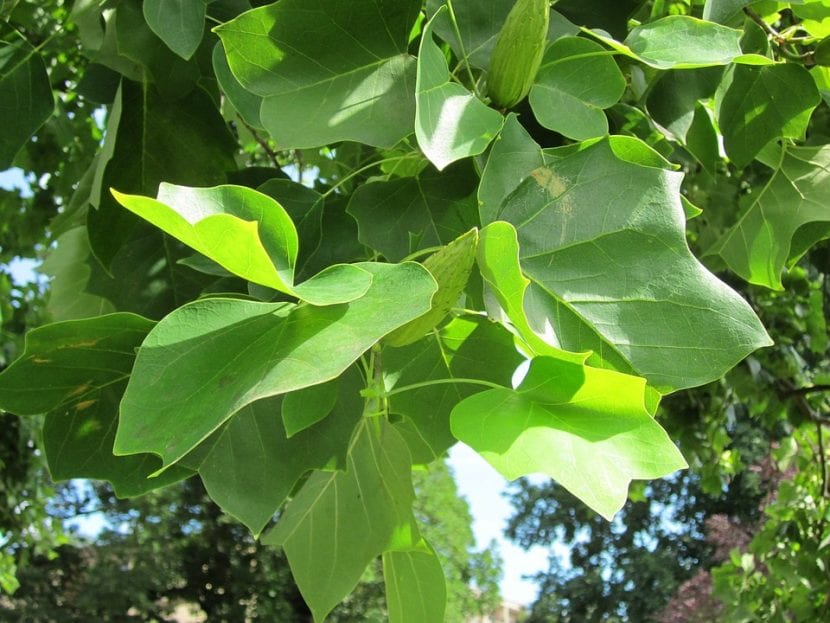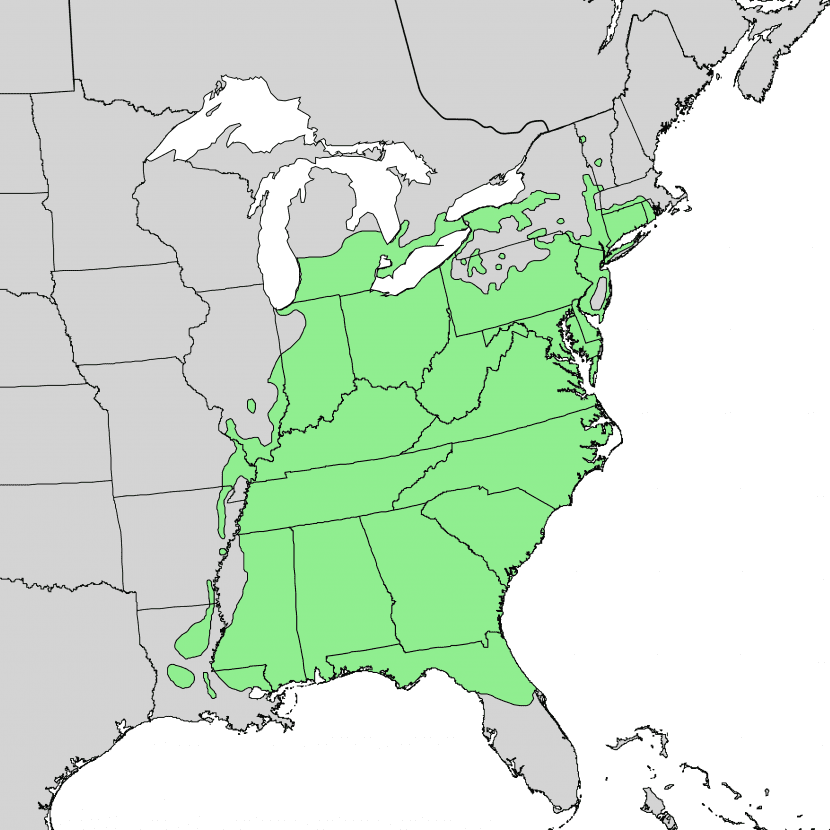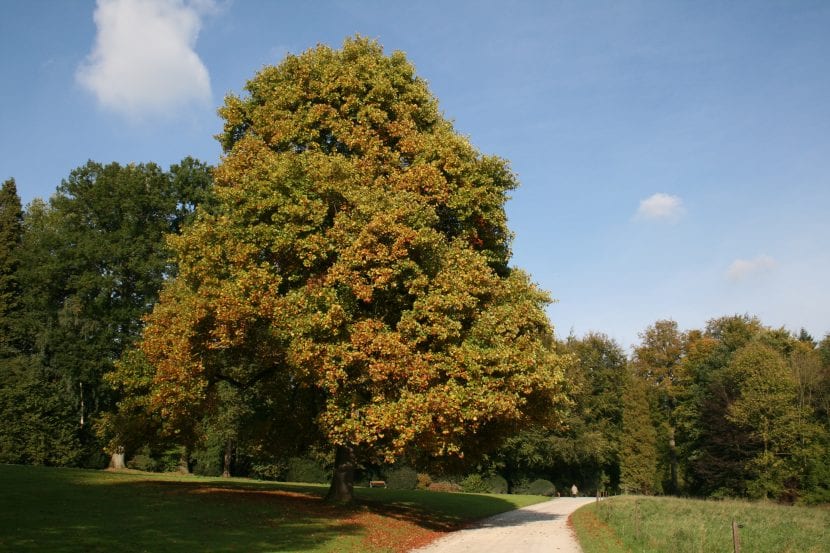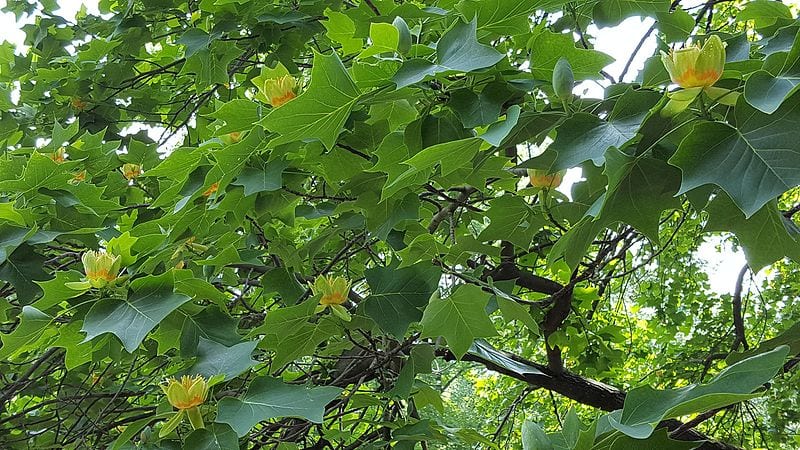
El Liriodendron tulipifera It is a tree of those that reaches impressive heights and that, to be able to see them completely, you have to move away a few meters and look up. And it is that with a height of more than 50 meters, there is no other 😉.
For this reason, it is not a suitable plant for small gardens; However, its growth rate is rather slow, so it can be grown in a pot, yes, for a limited time. Do we know it?
Origin and characteristics

Our protagonist it is a deciduous tree native to eastern North America, specifically southern Ontario (Canada) east of Illinois, reaching southern New England, southern and central Florida and Louisiana. It is popularly known as the tulip tree, tulip tree, tulip tree, Virginia tulip tree, tulip tree, or tulip tree.
It grows to a height of 50 meters, the most common being 16-26m, with a trunk diameter of up to 2,5m. The leaves are alternate, simple, heart-shaped or truncated, 12 to 15 cm long. The flowers, which sprout in spring, are solitary, terminal, yellowish-green and 2,5 to 5cm long.. And the fruit is a narrow brown cone that ripens in autumn.
There are two varieties:
- Liriodendron tulipifera var. fastigiatum: reaches 16-18 meters, with a trunk diameter of up to 1,5m.
- Liriodendron tulipifera var Aureomarginatum: has yellow leaf margins.
What are their cares?
If you want to have a copy, we recommend you take care of it in the following way:
Location
Must be abroad, in full sun or in semi-shade. Due to its size, it is important that it is planted at a distance of at least 10 meters from walls, pipes, large plants, etc., so it can grow correctly and you can enjoy it without worries.
Earth
- Garden: it has to be fresh, well drained and acidic. The limestone is afraid.
- Flower pot: during its first years of youth it can be kept in pots with substrate for acidic plants that you will find for sale here. But if the climate is somewhat warm (like the Mediterranean), you better use akadama (for sale here) mixed with 30% kiryuzuna (you can buy it from here).
Irrigation

Image - Wikimedia / Jean-Pol GRANDMONT
El Liriodendron tulipifera It is a tree that does not withstand drought at all, but it is not very good either to have its roots flooded (except if it is in a specific way). When it lacks moisture, the leaves quickly turn yellow, and that's just the thing to avoid. So that everything goes smoothly and the plant enjoys good health, it is advisable to water it 4-5 times a week during the summer, and a little less (about 2 times a week) the rest of the year.
You have to use rainwater or lime-free, but if the one you have is calcareous, add one or two tablespoons of vinegar in 5l / water. Check that the pH drops to between 4 and 6, since if it drops further, it will be toxic for the specimen. This can be done with the pH strips that are sold in pharmacies or here.
Subscriber
Throughout the growing season (spring and summer) must be paid with fertilizers such as guano (here you have it in powder and for here liquid), the manure or humus for example. If it is on the ground, spread a layer about 2-3cm thick all around the trunk and then mix it with the most superficial layer of the soil; and if instead you have it in a pot, use liquid fertilizers following the instructions specified on the container.
Multiplication
It multiplies by seeds, or cuttings (hard). Let's see how to proceed in each case:
Seeds
The planting of this tree is divided into two phases:
Phase 1 - Stratification in the fridge for three months (winter)
- First, a tupperware is filled with vermiculite previously moistened with lime-free water.
- Then, the seeds are sown and sprinkled with copper or sulfur to prevent the appearance of fungi.
- They are then covered with a layer of vermiculite (on sale here).
- Finally, the tupperware is covered and placed inside the refrigerator, in the section for dairy products, eggs, etc.
Once a week you have to remove the tupperware and open it to renew the air inside.
Phase 2 - Sowing in seedbed (spring)
- First, a seedbed (pot, tray with holes, etc.) must be filled with substrate for acidic plants.
- Then, a maximum of 3 seeds are sown in each pot or socket, and covered with a thin layer of substrate.
- Next, sprinkle with copper or sulfur.
- Finally, it is watered with lime-free water and the seedbed is placed outside, in semi-shade.
This will germinate after 1-2 months.
Cuttings
Multiplying it by cuttings is difficult, since they tend to rot quickly. But you can have a greater chance of success if you take semi-woody branches in summer, impregnate the base with homemade rooting agents and then the plants in pots with previously moistened vermiculite.
So they are likely to emit their own roots after a month or so.
Pruning
In late winter you can prune a little, and never forcefully. Removing dry, diseased, weak, or broken branches will do you good, but don't overdo it or you won't get over it.
Planting or transplanting time

In autumn when losing the leaves or, if you live in an area where the frosts are strong and / or late, in spring (towards April / May in the northern hemisphere).
Pests
It is very resistant in general, but it is vulnerable to the attack of:
- Mealybugs: cottony or limpet-like. They feed on the sap of the leaves.
They are fought with paraffins, or anti-mealybug insecticides. - Aphids: they are insects of less than 0,5cm of green, brown or yellow color that also feed on sap from leaves, as well as flowers.
They are fought with potassium soap, or with biological control with the help of ladybugs.
Rusticity
The tulip tree easily withstands frosts of up to -18ºC; however, it is harmed by extreme heat (over 30ºC). It does not live in climates without frost, even if it only dropped to -2ºC, it would not have a good development.
What uses does it have?
Ornamental
It is a beautiful plant, ideal to have as an isolated specimen in large gardens. The flowers, appearing in spring, cheer anyone who sets his gaze on them, as they are also fragrant.
It is also used as a street tree, but this should not be done in polluted cities as its leaves are sensitive to sudden changes in light, high concentrations of ozone and air pollution.
Medicinal
The inner bark is extracted from the root, which although it is bitter used as a heart stimulant and as a tonic.
Wood
Being flexible, it is used to make furniture.

Image - Wikimedia / Роман Рябенко
What did you think of the Liriodendron tulipifera?